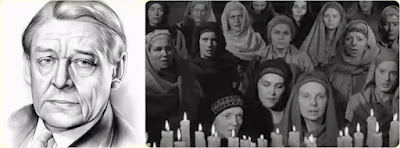Also Read
T.S. Eliot's Murder in the Cathedral is, in one sense, a historical play. The "murder" refers to the killing of Thomas Becket, Archbishop of Canterbury, in December 1170 in the Cathedral of that town. It is generally supposed that some knights killed him on orders from the King. Henry II. Thomas had been a friend of the King who had appointed him first as Lord Chancellor of England. and later as the Archbishop of Canterbury. It had, however, been an error of judgement on Henry's part to have supposed that Thomas as Archbishop would be the same kind of friend as Thomas, Lord Chancellor. Henry's hopes - that Thomas would support him in his conflict with the clergy over the State's supremacy over the Church - were belied. Thomas opposed the King's measures against the special privileges of the clergy. As a result Thomas was exiled and he lived in Europe for seven years. Following a superficial reconciliation, Thomas returned to England.
Historical facts artistically woven into the play. Eliot's play begins just before Thomas's return to Canterbury, for the play has been designed according to classical norms of concentrated action. But historical facts are brought in and revealed through the various speeches, We get to know of Thomas's exile; the Chorus conveys to us the foreboding that the peace is to be short-lived. Thomas's past, his friendship with the King, his earlier ambitions and positions are all revealed in the speeches of the Priests and the Tempters. Thomas is finally killed by the four Knights who declare that they act on their King's orders. Historically, when Becket published the order excommunicating the Bishops who had assisted in the coronation of Henry's son in the absence of the Archbishop, Henry II is reported to have exclaimed in fury: "Why no one could rid him of this low born priest". Four of his knights took up the task and killed Thomas in the cathedral of Canterbury. So far as the above details go, Eliot has woven historical detail into the texture of his play. History is not, of course, blatantly used. It is subject to the artist's careful selection and technique of dramatic concentration. Thus, we came to know of Thomas' s past history and the background to the present situation through the speeches of the Chorus, the Priests, the Tempters and the Knights, besides the words of Thomas himself.
Departure from mere history. Towards the end of the play, however, Eliot does not follow historical fact. The four Knights step out of their mediaeval setting after murdering Thomas and speak directly to the twentieth century audience. They use modern concepts, idioms, even slang, as they try to justify their action. 'The Knights' Apologia is a definite departure from historical fact.
Aim of poetic drama : its "doubleness of action". Murder in the Cathedral is not just a historical play; it is a poetic drama. It is not limited to the representation of the killing of Thomas. It deals with martyrdom - so much so that one notes a very important historical figure connected with the historical event of Becket's murder, namely, Henry II, is kept out of the play altogether. The conflict between State and Church, historically most important, is only implicit in the play and not dealt with in detail. The central theme is martyrdom - and not merely the particular martyrdom of Becket but the general significance of "acting" and "suffering" and the relevance of martyrdom to the common man. One cannot ignore the spiritual progress of the Chorus of women representing common humanity. The spiritual progress - from initial aversion to positive involvement and acceptance of Thomas's martyrdom - of the Chorus is integrated with the primary action of the play. It is the Chorus which mediates between audience nd action, and builds up an atmosphere of powerful tension in which the audience is remorselessly involved.
Murder in the Cathedral exhibits the "doubleness of action" which, according to Eliot, is a characteristic of poetic drama. It removes the play from the level of mere history. As the play explores the true meaning of martyrdom, as Thomas himself realizes it, the issue is also made relevant to the present times. The death of Becket is not treated as a historical event alone, but as a spiritual examination of martyrdom. It is in this context that the Apologia of the Knights become interesting and significant.
Conclusion: T.S. Eliot uses the historical facts of Becket's martyrdom to suggest a moral vision of universal relevance. Eliot has reinforced historical facts with Greek and Christian myths to enrich the texture and widen its scope of interest.
